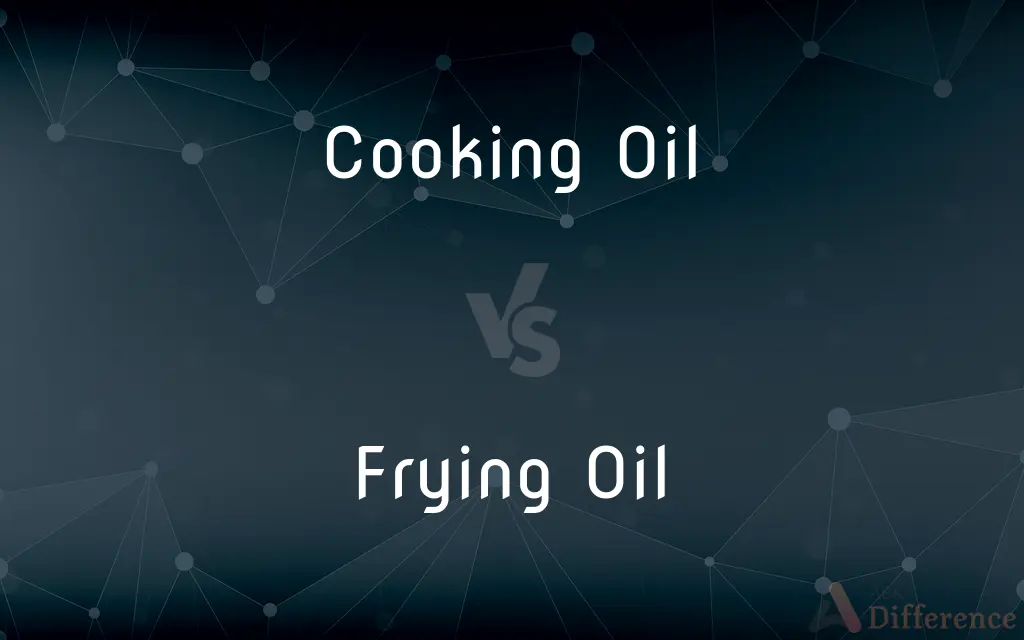Cooking Oil vs. Frying Oil — What's the Difference?
Edited by Tayyaba Rehman — By Fiza Rafique — Published on October 24, 2023
Cooking Oil is a general term for oils used in food preparation, encompassing various types and flavors. Frying Oil typically refers to oils with a high smoke point and stability, suitable for high-temperature cooking.

Difference Between Cooking Oil and Frying Oil
Table of Contents
ADVERTISEMENT
Key Differences
Cooking Oil can be described as any oil utilized in the preparation of food, embracing various cooking methods like sautéing, grilling, and baking. Frying Oil, in particular, is a subset within the cooking oil category, being characterized by its ability to handle high cooking temperatures without breaking down. The distinction between cooking oil and frying oil may be subtle but significant, especially when considering culinary techniques and food quality.
When examining functionality, Cooking Oil is vital for various techniques such as sautéing, marinating, and baking due to its role in flavor, texture, and cooking efficacy. Frying Oil, on the other hand, demands a notable characteristic: a high smoke point, ensuring that it remains stable and doesn’t burn or smoke under intense heat. Both oils serve distinctive purposes in culinary applications, ensuring that foods are cooked or flavored effectively.
Taking a look at health considerations, Cooking Oil can come in various forms, with some being regarded as healthier options, such as olive oil, due to their beneficial fat content. Frying Oil must balance health considerations with functionality, ensuring that it can withstand high heat while also not contributing negatively to the nutritional profile of the food. Both types of oils must be considered in a dietary context, considering both their cooking and nutritional aspects.
From a culinary perspective, Cooking Oil can bring diverse flavors to a dish, with oils like sesame or olive oil often used to enhance the taste profile of various recipes. Frying Oil might sometimes be chosen for its neutral flavor, to ensure that the original taste of the food being fried is not overshadowed. Cooking oil and frying oil can thus play distinct roles in flavoring, either becoming a feature of the dish or allowing other ingredients to shine.
In the commercial food industry, Cooking Oil is utilized in a plethora of products, encompassing a range from salad dressings to baked goods. Frying Oil is especially critical in fast-food operations and snack manufacturing, where consistent, high-heat cooking is a requisite. Both oils contribute vastly to the food industry, ensuring products and dishes are crafted to desired textures, flavors, and qualities.
ADVERTISEMENT
Comparison Chart
Usage
General cooking applications
Primarily for high-heat frying
Smoke Point
Varies, not always high
Typically high
Flavor Profile
Can be flavorful or neutral
Often neutral
Health Considerations
Varied options available
Must balance stability with health
Examples
Olive oil, sesame oil
Canola oil, peanut oil
Compare with Definitions
Cooking Oil
Cooking Oil may come in various types, each with distinctive properties and flavors.
Coconut cooking oil imparts a subtle sweetness to baked goods.
Frying Oil
Frying Oil is used in deep-frying and pan-frying culinary applications.
French fries are typically cooked in frying oil to achieve a crispy texture.
Cooking Oil
Cooking Oil can act as a medium for heat transfer in various cooking methods.
Cooking oil is often used to sauté vegetables.
Frying Oil
Frying Oil often possesses a neutral flavor profile.
Frying oil used for doughnuts typically does not impart additional flavors.
Cooking Oil
Cooking Oil can be used as an ingredient in recipes.
Salad dressings often contain olive oil for richness and flavor.
Frying Oil
Frying Oil must be monitored carefully to avoid overheating and breaking down.
Maintaining the correct temperature of frying oil ensures consistent and safe cooking.
Cooking Oil
Cooking Oil is fat derived from plant, animal, or synthetic sources used in food preparation.
Olive oil is a popular cooking oil used in Italian cuisine.
Frying Oil
Frying Oil can be reused if filtered and stored properly.
Some restaurants filter and reuse frying oil for economic efficiency.
Cooking Oil
Cooking Oil can provide flavor and texture to dishes.
Sesame oil adds a nutty flavor to stir-fried dishes.
Frying Oil
Frying Oil is chosen for its stability under high temperatures.
Canola oil is frequently used as frying oil due to its high smoke point.
Common Curiosities
Can all Cooking Oils be used for frying?
Not all cooking oils are suitable for frying due to varying smoke points and flavor profiles.
Can Frying Oil be reused?
Frying Oil can be reused if it’s filtered and stored properly to maintain quality.
Why is a high smoke point important for Frying Oil?
A high smoke point in frying oil prevents it from breaking down and smoking at high temperatures.
What is Cooking Oil primarily used for?
Cooking Oil is used for various cooking methods, such as frying, sautéing, and baking.
What is a popular Cooking Oil used in salad dressings?
Olive oil is commonly used in salad dressings due to its flavorful profile.
Does Cooking Oil expire?
Yes, cooking oil does expire and should be checked for signs of rancidity.
Are there health-focused Cooking Oils?
Yes, some cooking oils like olive oil and avocado oil are noted for their health benefits.
What is a neutral Frying Oil used in many restaurants?
Canola oil is a neutral frying oil often used in restaurants.
How often should Frying Oil be changed in a deep fryer?
The frequency for changing frying oil depends on its usage and the type of food being fried.
Should Frying Oil be filtered between uses?
Filtering frying oil between uses can extend its lifespan and ensure quality.
How should Cooking Oil be stored?
Cooking Oil should be stored in a cool, dark place, ideally in a tightly sealed container.
Is it safe to dispose of Frying Oil down the drain?
It's not advisable to dispose of frying oil down the drain as it can cause blockages.
How does Cooking Oil impact the flavor of a dish?
Cooking Oil can enhance, neutralize, or even alter the flavor of a dish depending on its type.
Can Cooking Oil be substituted for another in recipes?
Substituting cooking oil can be done, considering flavor and smoke point for the particular recipe.
How do you properly dispose of Frying Oil?
Frying oil should be cooled, potentially strained, and disposed of in a sealed container.
Share Your Discovery

Previous Comparison
Dependant vs. Dependent
Next Comparison
Bank Rate vs. Base RateAuthor Spotlight
Written by
Fiza RafiqueFiza Rafique is a skilled content writer at AskDifference.com, where she meticulously refines and enhances written pieces. Drawing from her vast editorial expertise, Fiza ensures clarity, accuracy, and precision in every article. Passionate about language, she continually seeks to elevate the quality of content for readers worldwide.
Edited by
Tayyaba RehmanTayyaba Rehman is a distinguished writer, currently serving as a primary contributor to askdifference.com. As a researcher in semantics and etymology, Tayyaba's passion for the complexity of languages and their distinctions has found a perfect home on the platform. Tayyaba delves into the intricacies of language, distinguishing between commonly confused words and phrases, thereby providing clarity for readers worldwide.












































